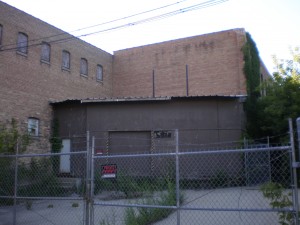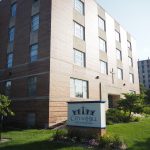Hide House Debate. Historic Preservation Or?

Hide House
On Monday July 20th, General Capital will go before the Historic Preservation Commission and request permission to demolish a portion of the Hide House complex. This demolition would allow for the construction of a 60-unit affordable housing apartment building. At the previous meeting of the Historic Preservation Commission a nomination for historic status of the entire Hide House complex was requested by Alderman Zielinski, and despite various sections of the complex being of varying ages and having questionable historical importance the entire complex received historic status.
This designation seems questionable. For one it is questionable as other tanneries throughout Milwaukee with similar histories have not received historic designation. In fact a few tanneries have been demolished to allow for new development projects. For example, to make way for Mandel Group’s North End project the Pfister & Vogel Tannery on Water St. was demolished. Further, the Wisconsin Historical Society didn’t deem the complex worthy of historic status. Finally, and most importantly this designation is questionable, because of the statements by community residents and actions by leaders in opposition to this project that revolve around its “low-income,” component and issues unrelated to preservation. For example these are just a few of the comments and quotes on the topic:
This comment was left on the Bay View Compass article “Development struggle at Hide House,” by a user named Paul.
There are a few issues not addressed in this article.
First, No matter what it is called, it is still LOW income. Where else can you get a one bedroom apartment for $300? The going rate in Milwaukee is about $700. Low income usually brings in a bad element, even if it is not intended.
Second, there was standing room only at the hearing, all from the neighborhood and 95% were against this project. In fact, the article failed to mention that the owners had applied for a permit to tear down the building and start begin the process the day before the hearing…this seems like they have some other motive.
Third, this is a fairly landlocked area, and bringing in 60 units with 2 cars each would add a heck of a lot of traffic to my neighborhood, which has a lot of kids.
Finally, I will be presenting a request for a ground contamination study before any work can be done. Tanneries had often used Chromium and Mercury in their processes in the past. This entire site could be contaminated. The last thing we want is for a large number of poor people to get sick and then bring cases against the city for approving this project.
This comment was left on the Journal Sentinel article “Bay View apartments project at former tannery hits road block,” by Susan Robitaille.
Hello,
Just to clarify…
These apartments are not ‘moderate income’, they are most definately LOW income. The residents were not allowed to speak about the upcoming development… it was merely a meeting (the first we were given by the way), to speak our minds about our feelings about the historic nature of the Hide House. In response to the person accusing anyone of racism… at what point is poverty a matter of race/color/creed? Not one person around here gives a rip about that sort of thing. There are all colors and cultures in this neighborhood and we celebrate our diversity.
The fear of a low-income housing rental structure in our neighborhood is the issue… along with the fact that there is no outlet to major streets, means we will have more cars racing down our quiet neighborhood.
Be real. Ask yourself if you would want that extra burden of traffic coming into your direct neighborhood… would you want the extra noise associated with that?
If low-income housing is so great… why not welcome it with open arms into your neighborhood? No? I thought not.
Low-income apartments, no matter how they are sugarcoated, will attract “undesirable” people.
These are just a few of the troubling statements being made regarding the Hide House Lofts project.
Another indication that this debate isn’t about historic preservation is that Alderman Zielinski didn’t bring this historic designation forward when General Capital Growth was intent on demolishing this section of the complex to build condominimums on the site. In fact it wasn’t until the project received WHEDA tax credits that the he nominated the complex for historic preservation. Further, according to the Bay View Compass, in an email dated June 17, 2009, sent from Alderman Zielinski to the developer, Alderman Zielinksi wrote:
In order to make sure the residents know exactly what you are proposing I am requesting a meeting where your staff can make a presentation to my constituents. Afterward, there can be Q and A etc. If you can convince my constituents that the ‘entire’ building should not be preserved then I will change my position. Whatever my constituents support then that is what I support.
It appears that Alderman Zielinski is saying his stance on the issue is based on constituent vote, not on whether or not this building deserves historic preservation. This is troubling to say the least. Now, it is possible that the Hide House complex deserves hisoric status, but these comments and actions makes it clear that the opposition to this development has little to do with historic preservation. This hurts the process, and does a disservice to our city.




















The neighbor’s actual concern seems to be quite limited to the mere element of change, as well as concern for the “bad elements” that may come to live there.
But the “bad elements” could be the ones that already “inhabits” the area, such as the artists in other parts of the building, mentioned in one of the above articles. With a sort of cultural atmosphere already present the adding of affordable housing will only increase the dynamics of the area.
What is left with the neighbors is an unwillingness to accept change. This mere feeling should NEVER interfere with important projects such as this. Change is a natural state, there is no status quo in a dynamic and living city.
By that the builder will still have to take care of such things as pollutants (if there are any), but I am sure they will be happy to do it if they are only allowed to build. Actually, if they were not about to build then they would never do anything to the pollutants, which would still be left in the ground. This is an opportunity.
@Eric Agreed There is most certainly with this and well most projects an element of opposition that is all about preserving the status quo. In this case it looks to run a little deeper than even that.
Further you’re right again in saying that without the new development whatever toxins exist (my guess is it is a pretty dirty site) would remain in the ground, not be cleaned up. With the development some sort of cleanup is now likely.
There are a lot of vacancies in the city already for one-bedroom apartments that run a lot less than $700. Many people can’t even afford $450 including heat: true fact. Another true fact: poverty is a complex issue. Simply put, crime makes the news. People helping each other out- or trying to- doesn’t make the news nearly as often. And, lastly, fear is a powerful motivator.
That said, I don’t believe that having big intensely-concentrated buildings full of families struggling with poverty is necessarily a good idea. Milwaukee’s scattered-site rent assistance program vs. Chicago’s Cabrini Green, anyone?
@Suzanne The Hide House Lofts project is only 60 units so it really is on the smaller scale. To me it is important that we build out city in a way that allows all income levels to live an enjoy our neighborhoods.
The developers will be getting guaranteed income from the tax credits, hence the attraction to having purely low income housing. A better use would be a mixed income development where there is a variety of incomes living in the same area, but then the developers do not have a guaranteed income, and it’s more of a risk.
@Patty I agree, in that I think mixed-use project with a mix of income levels could be better. That said, none of this has anything to do with Historic Preservation, that’s the problem. Our preservation laws are being twisted and spun in an effort to stop a project (likely because of the low-income component), and that makes the entire process a sham, removes certainty from the system, and opens the process up for legal challenges. I’ve seen time and time again that our preservation laws are used to stop development, not to encourage preservation and that’s troubling.
I live and own a home in the Historic Brewer’s Hill Neighborhood. We have a WHEDA subsidized housing project (recently constructed) in our neighborhood. I would most certainly welcome another project of similar character. We have had no problems regarding that development and I’m certain the MPD will confirm the same.
The Hide House Lofts project meets the zoning requirements for the site and it does not require any public hearings or special approvals. If the local residents are concerned then they should have petitioned the City to change the zoning years ago.
The application of the Historic Protections for the Hide House is unfortunate in that it just delays the City’s ability to realize a significant increase in the property’s value and its associated taxes. Secondly, the Historic Protection provided by the HPC is for cultural value and not architectural significance opens the door for the razing of the least desireable and longest vacant portion of the building.
The complex was originally constructed as a multi-tenant manufacturing facility and was purchased by the Greenebaums in the 1920’s. The Kaiser’s purchased the facility in the 1950’s (Another Kaiser Tannery on the City’s north side was demolished to make way for……yup, another WHEDA project). The Greenebaum’s appear to have not treated their employees fairly and had Federal Court orders against them in the 1940’s……interesting that we’d want to perserve the history of an out of State business that treated Milwaukee residents so poorly.
I resent the implication of lower income publc housing equals “bad” people. I’ve lived and owned a home in Historic Walkers Point for the past 30 years. I once worked in Greendale. There I was asked why I lived in such a “bad” area of town. These were the same people who were up in arms because a proposed low income home for developmentally disabled individuals was being proposed for their community. The comment I heard was:”It will lower our property values”. I assume these people also went to church on Sunday. I love my neighborhood and good and bad things have happened to me here, the same as would have happened anywhere else in this city, and I have lived in other neighborhoods in Milwaukee. Verdict: good and bad people live everywhere. What’s going on at the Hide House (by the way, I had an art studio there for 4 years) is plain and simple old prejudice and fear. It is a very historic building but there are parts of it that are beyond repair. I think the proposed idea is a good one and would contribute positively to their neighborhood.